Miscellaneous cnidarians [sea anemones, corals, etc]
Phylum: CNIDARIA
A place for messages concerning miscellaneous cnidarians [sea anemones, hydroids, sea pens, jellyfish, corals, soft corals etc]. See also General Topics Index for Fact Sheets on specific cnidarians.
Related messages
Strange seaslug? in Florida
August 5, 2006
From: Andrew Cook
On a recent trip to Coquina Beach, Bradenton, Florida, USA, my friend and I observed what appeared to be a sort of seaslug. They were in the intercoastal waterway in about two to three feet of water. We saw many of these, thirty to forty, in a small area. At first I thought I was looking at a seastar because of their shape. They had five arms and were covered with leafy protuberances on the top. They were brownish with some greens. Under, they had a round foot about four inches in diameter. When I lifted one it swam back to the bottom in an undulating motion. They ranged in size from three to six inches in diameter. If you have any idea what we saw I would be interested to know what it was.
Locality: Coquina Beach, Anna Maria Island, Bradenton Florida, USA, Gulf of Mexico, 26 July 2006, 2-4 ft, muddy bottom. Length: 3-6 in.
Andrew Cook
lanaibrat@verizon.net
Cook, A., 2006 (Aug 5) Strange seaslug? in Florida . [Message in] Sea Slug Forum. Australian Museum, Sydney. Available from http://www.seaslugforum.net/find/17311Dear Andy,
From your description I suspect you saw a group of large jellyfish - swimming and resting upside down, probably Cassiopeia. By chance I have recently posted a message from Carlos Munda, with photos, of this type of jellyfish from the Philippines [#17236]. I have given some background information on why they swim upside down there.
Best wishes,
Bill Rudman
Re: Solar-powered jellyfish from the Philippines
July 29, 2006
From: Carlos Munda
Concerning message #17236:
Dear Bill
Thanks so much for identifying it for me.
Carlos Munda
c_munda@yahoo.com
Munda, C, 2006 (Jul 29) Re: Solar-powered jellyfish from the Philippines. [Message in] Sea Slug Forum. Australian Museum, Sydney. Available from http://www.seaslugforum.net/find/17258Solar-powered jellyfish from the Philippines
July 28, 2006
From: Carlos R. Munda
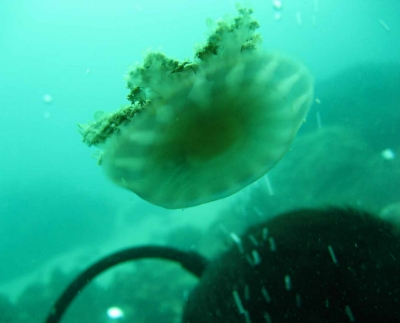
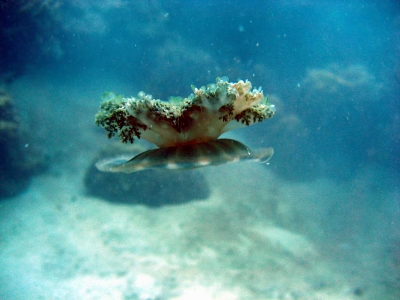
Would anyone know what this is?
Locality: beach, 10-15 feet, Philippines, pacific, 22 July 2006, sandy. Length: 5 inches. Photographer: carlos r. munda, jr..
thanks
Carlos R. Munda
c_munda@yahoo.com
Munda, C, 2006 (Jul 28) Solar-powered jellyfish from the Philippines. [Message in] Sea Slug Forum. Australian Museum, Sydney. Available from http://www.seaslugforum.net/find/17236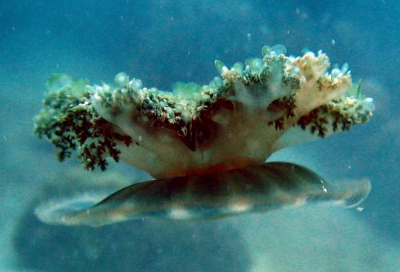
Dear carlos,
I am not very good at keeping to my promise to deal only with sea slugs - what with sea pens from Western Australia [#17207] and sea anemones from Marseille [#17197], now we have a solar-powered jellyfish. This amazing animal, Cassiopeia andromeda, swims, floats or rest on the bottom upside down, so that its fleshy 'arms' or 'tentacles', which are packed full of single celled zooxanthellae, get the optimum amount of sunlight for photosynthesis. See the Fact Sheet on Solar powered sea slugs for background information.
Whenever I find these jellyfish I search them for aeolid nudibranchs, because they seem to be an ideal food. So far I have had no luck in the Indo-West Pacific, but in 1985, Brandon and Cutress described a species, Dondice parguerensis, from a Caribbean species of Cassiopeia. I was at the time working on solar powered nudibranchs so I was interested in knowing if D. parguerensis was taking the zooxanthellae from the jelly fish and re-using them itself. Unfortunately I couldn't tell from the specimens they sent me, but more recently Dave Behrens has sent photos of that species and it seems they don't. However I still think its worthwhile having a look at this jellyfish in the Indo-West Pacific for an aeolid. There is nothing to say there isn't one recycling zooxanthellae in the Pacific.
Best wishes,
Bill Rudman
Re: Mystery from Marseille
July 28, 2006
From: Baki Yokes
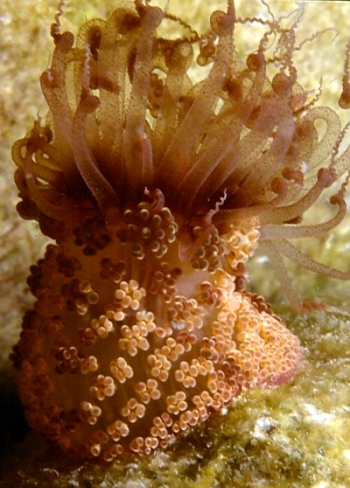
Concerning message #17197:
Here is a photo of an extended Alicia mirabilis individual. The photo was taken by Adnan Buyuk at Antalya, Turkey
Baki Yokes
bakiyokes@turk.net
Yokes, M.B., 2006 (Jul 28) Re: Mystery from Marseille. [Message in] Sea Slug Forum. Australian Museum, Sydney. Available from http://www.seaslugforum.net/find/17254Dear Baki,
Thanks very much. I see now that the whole object is one animal. I had assumed that it was a colony and that each of the tubercles in Nadine's photo was a contracted polyp.
Best wishes,
Bill Rudman
Re: Mystery from Marseille
July 27, 2006
From: Cristian Magnani
Concerning message #17197:
Dear Bill
The animal depicted in the photos is definitely a sea anemone called Alicia mirabilis: the most beautiful and the most painfully stinging one in the Mediterranean. this anemone expands only at night showing its tubercled body and its long hairy tentacles, while during the day it retracts and looks very different. It is not very common and often overlooked due to its dull day-time apparence.
Hope this helps
Best regards
Cristian
http://www.nudibranchi.it/Eng_main.htm
info@nudibranchi.it
Magnani, C., 2006 (Jul 27) Re: Mystery from Marseille. [Message in] Sea Slug Forum. Australian Museum, Sydney. Available from http://www.seaslugforum.net/find/17245Thanks Cristian,
It's great to have 'unidentifieds' solved so quickly
Best wishes,
Bill Rudman
Mystery from Marseille
July 27, 2006
From: Nadine Neels
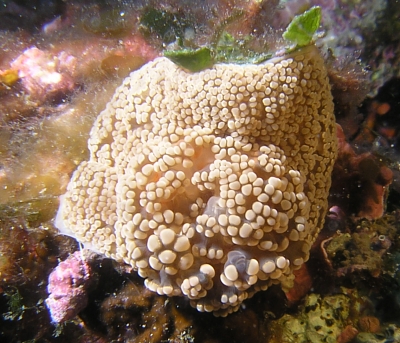
Please could you define what we have seen in Marseille. Is it a sea slug or something else?
Locality: Marseille, 15 metres, France, Mediterranean Sea, 21 June 2006, Clear water. Length: 9 cm. Photographer: Christian Piron.
Thanks in advance.
Nadine Neels
neelsnadine@yahoo.fr
Nadine N., 2006 (Jul 27) Mystery from Marseille. [Message in] Sea Slug Forum. Australian Museum, Sydney. Available from http://www.seaslugforum.net/find/17197Dear Nadine,
Although it looks a bit like a tuberculate dorid, I am pretty sure this is not a nudibranch. It seems to be a colonial animal, almost certainly a cnidarian such as a soft coral or colonial sea anemone. However we are going to need some help from someone familiar with the Mediterranean fauna, to get an identification
Best wishes,
Bill Rudman
